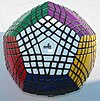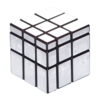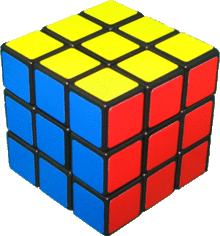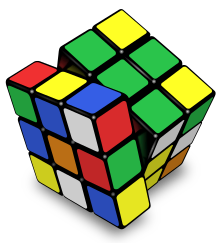Rotating puzzle
A rotating puzzle or rotating game is a three-dimensional , mechanical game of patience , which consists of several parts and can be manipulated by turning individual pages. The goal is to spin from a state where the game is twisted to a state that is accepted as solved. Probably the most popular rotating puzzle is the Rubik's Cube (" magic cube ").
Rotating puzzles are not placement games , which are also known as puzzles . The term puzzle comes from the English where all puzzles are called in this way.
functionality
Each side of a rotating puzzle consists of several parts called stones or cubies . Turning a page swaps stones so that the puzzle is changed.
Most rotating puzzles consist of black or white bricks to which colored surfaces are glued, or the bricks themselves consist of colored pieces (stickerless) . For most cube-shaped puzzles, the color scheme is as follows:
- White versus yellow;
- Green opposite blue;
- Red across from orange.
- If you hold the puzzle with the white side on top and the green side in front, then red is on the right (and orange on the left).
- Some rotating puzzles, in which the stones are white, have a black surface instead of the white one.
There are also rotating puzzles that are printed with pictures. These are often a little more difficult to solve because stones that only have one visible side must be correctly aligned. In the case of a single-colored center stone, e.g. B. With a Rubik's Cube, it is irrelevant how the stone is turned. There are also rotating puzzles that are monochrome. Such puzzles change their shape through rotation (whereas a Rubik's Cube always remains a cube). This property is called shape shifting .
The aim is to bring the puzzle from a twisted state (scrambled) to a solved state (solved) . Many rotating puzzles can also be taken apart and then reassembled. But if you put the puzzles together incorrectly, the puzzle may no longer be solvable. With a Rubik's Cube z. B. never a single corner stone can be turned. In the case of puzzles with stickers of poor quality, the stickers can also be peeled off and stuck on again. If the stickers are stuck on incorrectly, the puzzle can usually no longer be solved. In a Rubik's Cube z. B. the white side opposite the yellow. So there must be no corner or corner stone that has a white and a yellow sticker.
Speed cubing
Speedcubing means solving a rotating puzzle as quickly as possible. Official competitions for some rotating puzzles are held by the World Cube Association (WCA) ; but there are also unofficial competitions.
Most of the time, when solving speed cubes, it is important to achieve one of the following goals:
- Solving the rotating puzzle
- Solve the rotating puzzle with one hand
- Solve the turning puzzle with your feet
- Solve the rotating puzzle blindly (the rotating puzzle may be viewed beforehand, but the solution process must be done blindly)
- Solving the rotating puzzles blindly without looking first (for rotating puzzles that can change their shape (shape shifting) ; this is not a WCA discipline)
- Solve as many rotating puzzles as possible blindly
- Solve with as few moves as possible
Overview
N × N × N rotating puzzles
All N × N × N rotating puzzles have in common that they are cube-shaped and consist of seemingly cube-shaped cubies. The exception is the 7 × 7 × 7, which due to its size has to have curved surfaces or larger curb and corner stones. Even larger N × N × N rotating puzzles are commercially available, but will not be discussed in detail here.
Rotating puzzles with an uneven edge length have a center stone on each side, the position of which cannot be changed. This means that it is clear which color goes on which side. In puzzles with straight edges, any color can be on each side, but the arrangement of the colors must be correct relative to each other.
The rotating puzzles Rubik's Cube , 2 × 2 × 2, 4 × 4 × 4, 5 × 5 × 5, 6 × 6 × 6 and 7 × 7 × 7 are disciplines in competitions of the World Cube Association . For the puzzle Rubik's Cube also competitions in the 4 × 4 × 4, 5 × 5 × 5 Blind solving (Blindfolded) organized. The Rubik's Cube is the only rotating puzzle for competitions in solving with as few moves as possible (Fewest moves) , in one-handed solving (One-handed) , in blind solving as many puzzles as possible (Multiple Blindfolded) and in solving with the feet (With feet) .
| image | Surname | Levels | particularities |

|
Pocket Cube / Mini Cube |
2 | The pocket cube only consists of 8 corner stones. Nevertheless, solving the problem is not easy for laypeople. Each position can be solved in a maximum of 11 moves. |

|
Rubik's cube / magic cube |
3 | This is the classic Rubik's Cube. Each position can be solved in a maximum of 20 moves ( God's number ). |

|
Rubik's Revenge / Rubik's Master Cube |
4th | Unlike the Rubik's Cube, the 4 × 4 × 4 cube has no clear center stones. When solving it, you still have to consider which colors are opposite. A 4 × 4 × 4 cube can also simulate a 2 × 2 × 2 and 3 × 3 × 3 cube. |

|
Professor's Cube | 5 | The 5 × 5 × 5 again has center stones that show which side is assigned which color. |

|
6 × 6 × 6 cube | 6th | |

|
7 × 7 × 7 cube | 7th | The 7 × 7 × 7 has either outwardly curved surfaces or enlarged edge and corner stones so that it does not fall apart when rotated. |
Currently (2018) cubes with up to 33 levels are being produced with 3D printing .
Dodecahedral puzzles
In addition to cube-shaped puzzles, there are also dodecahedral puzzles. The first and best-known rotating puzzle of this type is the Megaminx . The Megaminx is the only dodecahedral rotating puzzle that is a discipline at WCA competitions.
| image | Surname | Levels | particularities |

|
Megaminx / Hungarian Supernova |
3 | A Megaminx can be seen in the picture; the Hungarian Supernova has slightly narrower curb stones. Megaminx is a WCA discipline. |

|
Gigaminx | 5 | The Gigaminx is larger and therefore more difficult to loosen than the Megaminx. |

|
Teraminx | 7th | |
| Kilominx | 2 | The Kilominx has no curb stones. |
More rotating puzzles
There are many more rotating puzzles. The most famous are listed here. The puzzles Pyraminx , Square-1 and Skewb are WCA disciplines. Puzzles marked with shape shifting can have a different shape after being rotated. The Rubik's Cube is not a shape-shifting puzzle, as it always retains the cube shape even after many rotations.
| image | Surname | Data | particularities |

|
Pyraminx | Shape: tetrahedron | The four corners can be rotated individually or (as can be seen in the picture) the level below. |

|
Square-1 / Back to Square One / Cube 21 |
Basic shape: cube shape shifting |
|

|
Skewb | Basic shape: cube | With the Skewb, corners can be rotated by 120 °, which means that the three squares that border the rotated corner and the three corners that lie between the squares also rotate. One move always turns half of the puzzle. |

|
Floppy cube | Basic shape: Cuboid shape shifting Mechanics: 3 × 3 × 1 |
The Floppy Cube loses its flat shape when rotated 90 ° . This allows the positions of the four corner stones to be changed, but not those of the four edge stones. |

|
Mirror Blocks / Mirror Cube / Bump Cube |
Basic shape: Cube shape shifting Mechanics: 3 × 3 × 3 |
The Mirror Blocks has the same mechanics as a Rubik's Cube , but the levels are not colored, instead they have different sizes. A twisted mirror block can therefore be solved blindly and without looking first. Mirror blocks are also available in other sizes, e.g. B. 2 × 2 × 2 or 4 × 4 × 4. |

|
Fisher Cube | Basic shape: Cube shape shifting Mechanics: 3 × 3 × 3 |
The Fisher Cube has the same mechanics as a Rubik's Cube , but has a cube shape rotated by 45 °, so that the cube shape is lost when turning. In addition, care must be taken to turn the center stones correctly. |
| Ghost cube | Basic shape: cube shape shifting |
The Ghost Cube does not have a symmetrical structure, but the mechanics of a 3 × 3 × 3 Rubik's Cube . The released state corresponds to a partially twisted 3 × 3 × 3 cube, in which the surfaces of the cube are not parallel to the rotating mechanism. The puzzle is not solved by color, but by shape. | |

|
Pyramorphix | Basic shape: Tetrahedron shape shifting |
|

|
Void Cube | Shape: cube-like Mechanics: 3 × 3 × 3 |
The only difference between the Void Cube and the normal Rubik's Cube is that, instead of the central stones, it has holes through which you can look. |
Other mechanical puzzles
There are three other mechanical puzzles that are not rotating puzzles, but are or were disciplines of the WCA . Rubik's Clock is the only current WCA discipline that is not a rotating puzzle. Before January 1, 2013, Rubik's Magic and Rubik's Master Magic were also on the list of disciplines.
| image | Surname | particularities |

|
Rubik's Clock | The position of the pointer can be changed by turning the four corner clocks. The four yellow buttons can be pushed in so that the hands of other clocks turn with them. The buttons on the back (which also has nine clocks) are pushed out. |

|
Rubik's Magic | This puzzle can take on a different shape by bending and folding it. |

|
Rubik's Master Magic | Rubik's Master Magic is a larger version of Rubik's Magic. |
Individual evidence
- ↑ PuzzlePlus - Puzzle Story .
- ↑ Rubiks website ( Memento of the original from October 19, 2016 in the Internet Archive ) Info: The archive link was inserted automatically and has not yet been checked. Please check the original and archive link according to the instructions and then remove this notice.
- ^ List of competitions of the World Cube Association
- ↑ unofficial ranking in the disciplines 13 × 13 × 13 and Ghost Cube
- ↑ Video of the unofficial discipline Mirror Blocks blind
- ↑ a b c d List of disciplines and records of the World Cube Association
- ↑ Grégoire Pfennig's Rubik's Cube
- ↑ current Megaminx records on the World Cube Association website





